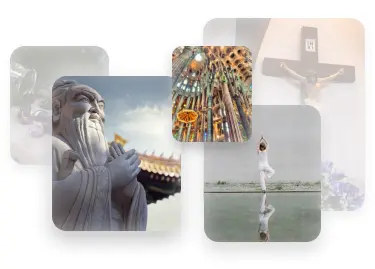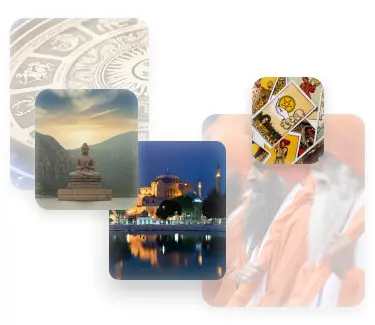The Christian religion is based on the teachings of Jesus Christ, who lived and preached in the 1st century CE in the province of Judea of the Roman Empire. Catholic theology teaches that the modern Catholic Church is a continuation of this early Christian community created by Jesus. Christianity spread throughout the early Roman Empire despite persecution by the state administration due to conflicts with the pagan state religion. Emperor Constantine legalized the practice of Christianity in 313, in 380 this faith became the state religion of the empire. The Germanic barbarians who invaded Roman territories in the 5th and 6th centuries CE, at first actively adopted Arian Christianity, and later leaned towards Catholicism. As a separate denomination, catholicism has existed since 1054.
Catholicism
Catholicism is one of the branches of Christianity that arose as a result of the first great schism of 1054.
Catholicism is actively covered on the pages of peer-reviewed scientific and philosophical journals and religious press published on all five continents.
Catholicism is distributed mainly in Western (France, Belgium, Italy, Portugal) and Eastern (Poland, Czech Republic, Slovakia, Hungary, Lithuania, partly Latvia and the western regions of Ukraine) Europe. It is dominant in the vast majority of countries in South America and practiced by about half of the believers in North America. There are also Catholics in Asia and Africa, but the influence of Catholicism is insignificant here.
Catholicism is the second largest religion in the world. By the end of 2018, the number of adherents of this branch of Christianity is 1.329 billion, which is 18% of the world’s population. Catholics represent about half of all christians in the world.
A brief history
In the VII-VIII centuries CE, the expansion of Muslim conquests after the arrival of Islam led to the domination of the Arabs in the Mediterranean. These processes severed political ties between this region and Northern Europe, as well as weakened cultural ties between Rome and the Byzantine Empire. Conflicts related to power in the church, especially with the authority of the bishop of Rome, culminated in the East-West schism in the XI century, dividing the church into Catholic and Orthodox. It should be noted that the first schisms in the Universal Christian Church already took place after the Ephesian (431) and Chalcedonian (451) councils. However, several Eastern churches still did not break off contacts with Rome. A number of churches suspended contact with Rome in the 15th century, resulting in the formation of the so-called Eastern Catholic Churches.
Early monasteries throughout Europe helped preserve the Greek and Roman classical civilization. Eventually, the church began to exert a dominant influence on the development of Western civilization (including worldview, morality, ethics, art, etc.). Many Renaissance figures were sponsors of the church. However, in the 16th century Catholicism faced serious challenges from the leaders of the Protestant Reformation, as well as secular intellectuals of the Enlightenment. At the same time, Spanish and Portuguese explorers and missionaries spread the influence of the church across Africa, Asia and the New World.
In 1870, the First Vatican Council proclaimed the dogma of papal infallibility, and the Kingdom of Italy annexed the city of Rome. In the 20th century, anti-clerical governments in secular states, including Mexico and Spain, persecuted or executed thousands of clerics. During World War II, the church condemned Nazism and protected hundreds of thousands of Jews from the Holocaust; however, its efforts were criticized as insufficient. After the war, religious freedom was severely restricted in communist countries that were involved in the Soviet political camp..
In the 1960s, the Second Vatican Council led to reforms of the church liturgy and a number of cult practices. In the face of intense criticism from both inside and outside, the church has at various times supported or confirmed contradictory doctrinal positions regarding sexuality and gender identification, including restrictions on clergy to males and moral appeals against abortion, contraception, sexual activity outside of marriage, remarriage after divorce without annulment, as well as same-sex marriages.
The essence
Catholicism has much in common with Orthodoxy and, at the same time, differs from other trends in Christianity by its system of doctrine, cult practices, and peculiar means of adapting to the rapid change in the social paradigm of modern times. Let us note the key characteristics of the Catholic doctrine.
The main dogma of the Catholic Church, which distinguishes it from other currents in Christianity, is the dogma of the infallibility of the Pope. It consists in the fact that the Pope of Rome, who speaks from the pulpit on certain issues of faith and morality, is infallible. The papacy sought to accept this dogma for centuries, but institutionalized it only in 1870, when it was adopted by the Catholic Ecumenical Council in the Vatican.
Seeking to increase spiritual and secular power, the popes made numerous alliances with kings, enjoyed the tutelage of powerful feudal lords, amassed extraordinary wealth and political influence.
The next dogma of Catholicism is the dogma of “purgatory”, adopted in 1439 at the Council of Florence. The meaning of the doctrine of “purgatory” is that the human soul after death falls into the so-called “purgatory” – a place between hell and paradise, staying in which the soul can be cleansed of sins and later be sent either to heaven or hell. The purification of souls is carried out by various tests. The relatives and friends of the deceased, with the help of prayers and contributions to the church, can ease the ordeal of the soul in “purgatory”. The fate of the soul was determined in this way not only by the behavior of a person in earthly life, but also by the material capabilities of the family of the deceased.
A very important position of Catholicism is the thesis about the special role of the clergy. According to the teaching, a person cannot earn God’s mercy on their own, without the help of the clergy, who yield significant advantages over the laity and have extraordinary rights and privileges. In particular, the Catholic creed prohibits believers from reading the Bible, since this is the exclusive right of the clergy. Catholicism considers only the Bible written in Latin, which is not spoken by the overwhelming majority of believers, to be canonical.
An extremely important role in Catholicism is played by the cult of the Virgin, or Madonna. Christianity adopted this cult from ancient religions, where the Mother of God was revered as a Mother-Goddess, the Goddess of fertility. In the Christian religion, the Mother of God was embodied in the image of the mythical Virgin Mary, who gave birth to the child Jesus, the son of God, from the “holy spirit”. In Catholicism, the veneration of the Virgin is elevated to a dogma, even sidelining the cult of God the father and Christ himself to a certain extent. The cult of the Madonna helps Catholicism to influence millions of women believers. The Catholic Church impresses upon women that in the person of the Virgin Mary they have an intercessor before God. It is believed that this entity can help them in all the predicaments of life.
Biography of the founder
The Apostle Peter (?-64/67) is one of the twelve apostles of Jesus Christ, the eldest among His disciples. The first bishop of Rome.
Modern leaders
Francis (1936) – 266th Pope of Rome
Scandals
The scandal around sexual harassment in the Catholic Church flared up in the 1990s – 2000s, associated with the identification of a number of cases of sexual abuse of children by priests, nuns and members of religious orders and the Roman Catholic Church.
Quite unexpected for the world community was the abdication of Pope Benedict XVI in 2013, which was the first in almost 600 years. Analysts and journalists partly attributed this move to the aforementioned scandals, although the official Vatican denies this, citing the deteriorating health of Benedict XVI.
Commandments
According to catholic dogma, the clergy have special rights to receive communion. If the laity commune only with the “body of God”, the clergy does with His blood (church wine). This emphasizes the special rewards of the clergy before God.
At the third Ecumenical Council (Ephesus, 431), Mary was recognized as the Mother of God, and in 854 the dogma of her “immaculate conception” and bodily ascension to heaven was adopted.
Along with the honor of the Mother of God, the cult of saints, the worship of relics and relics, is becoming significant in Catholicism. During the existence of the Catholic Church, about 20 thousand “saints” and about 200 thousand “blessed” were proclaimed. This process has intensified in recent decades. Pope Pius XI proclaimed 34 “saints” and 496 “blessed” over the 17 years of his pontificate, while Pius XII proclaimed an average of 5 “saints” and 40 “blessed” each year.
Catholic ideology is very mobile. This was clearly manifested in the decisions of the Second Vatican Council, which reviewed many ideas that no longer corresponded to the task of preserving religion. At the Council, as a result of four years of disputes, 16 documents were adopted that reveal the essence of contemporary Catholic modernism. Among them, it is necessary to single out four “Constitutions”: “On the Liturgy”, “On the Church”, “On Revelations”, “The Thirteenth Schema”, as well as nine decrees: on ecumenism, on the pastoral duty of bishops, on the Eastern Catholic Churches, on monasticism and etc.
Rituals
Catholic dogmatics establishes the need for systematic confession of believers before the clergy. Every Catholic should have his own confessor and regularly report to him about his thoughts and actions; salvation is impossible without systematic confession. Thanks to this requirement, the Catholic clergy penetrates into the personal lives of believers, every step of which is under the control of a priest or monk. Systematic confession thus allows the Catholic Church to have a significant impact on society, especially on women.
Among the religious provisions of the Catholic Church, there is also this: as if Christ, the Mother of God and the saints have so many merits that they are enough to provide otherworldly bliss to all existing and future humanity. God has placed all this stock of “good” deeds at the disposal of the Catholic Church; it can, at its discretion, allocate a certain part of these “good” deeds to believers for the redemption of sins and personal salvation, but believers must pay the church for this. The sale of Divine grace was managed by a special tribunal under the Pope. There, for money, one could get an indulgence — a papal letter giving believers absolution or determining the time during which it was possible to sin.
There are many peculiar things in the Catholic cult. The means of emotional manipulation of the feelings of believers are widely used. Splendor and solemnity are inherent in the Catholic cult. The service is accompanied by organ music, solo and choral singing in order to influence the feelings of believers, to cause religious ecstasy. Worship in the Catholic cult is conducted in Latin, which is incomprehensible to most believers.
Holidays
Christmas, Easter Sunday
Holy places
Montecassino, Basilica of St. Mary over Minerva, Santi Giovanni e Paolo.



 RU
RU
